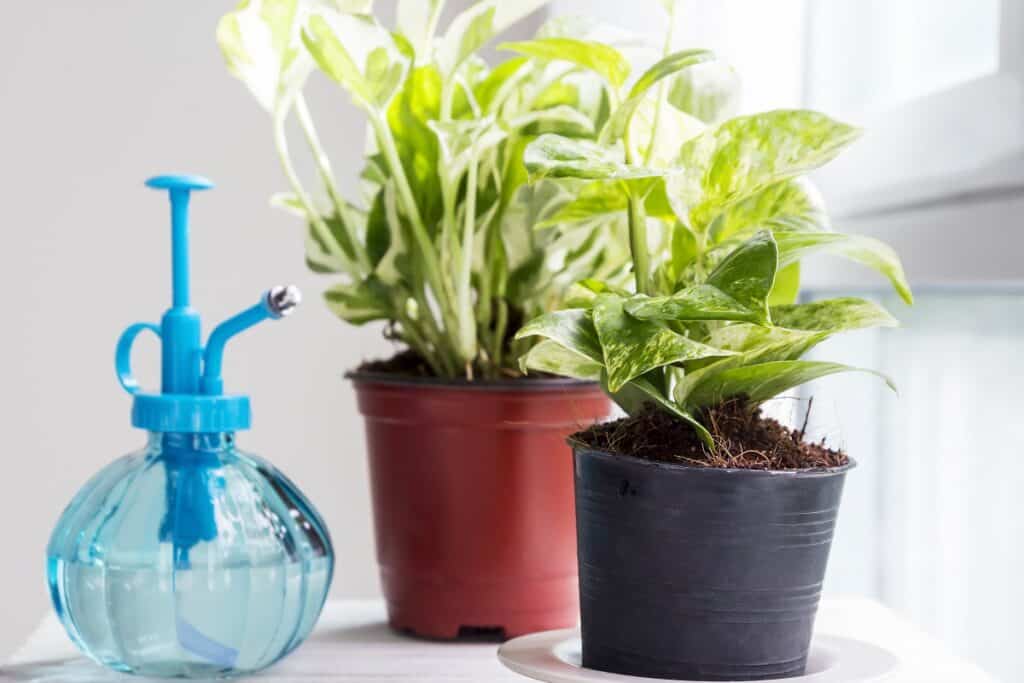The pothos, or devil’s ivy, is an iconic houseplant. It is a fast-growing, easy-care plant that is known for its trailing foliage. Its unique look and low maintenance requirements make it a great choice for those new to houseplants. But like any other plant, the pothos needs specific care to remain healthy. One of the most important factors for the pothos’ health is humidity. So, do pothos like humidity?

Contents
Do Pothos Like Humidity?
The humidity requirements for pothos plants, also known as devil’s ivy, are relatively low and easy to maintain. Pothos can thrive in average humidity levels, meaning levels between 50 and 70 percent. This level of humidity is easy to maintain in most homes, as it is generally the same as the humidity of a typical living space.
At the lower end of the ideal humidity range, pothos plants may need to be misted occasionally. This will help to keep them hydrated and healthy. The leaves of the plant may also need to be wiped down to remove dust and debris.
At the higher end of the ideal humidity range, pothos plants should be kept away from direct sources of humidity. This means avoiding areas such as bathrooms and kitchens, where humidity tends to be higher. It is also important to ensure that the soil is not too wet or soggy, as this can cause root rot.
Pothos also tolerate a wide range of humidity levels, so even if your home’s humidity level is slightly lower or higher than ideal, your pothos should still be able to survive and thrive. However, if you want your pothos to look its best, you should try to keep the humidity level in its ideal range, as this will help keep its leaves looking full and lush.

How To Increase Humidity For A Pothos
If you find that the humidity levels in your home are too low for your pothos, you can try to increase the humidity around your plant. One way to increase the humidity for a pothos is to mist the leaves with water. This can be done by using a spray bottle filled with water and lightly spraying the leaves. Doing this once or twice a week will help increase the humidity levels for the plant.
Another way to increase the humidity for a pothos is to place a humidifier close to the plant. This will help to raise the humidity levels in the surrounding environment, which will in turn help the pothos to thrive.
A third way to increase humidity for a pothos is to place the pot on a tray filled with pebbles and water. This will help to create a humid micro-climate for the plant, which will help it to grow and thrive.
Finally, grouping pothos together can also help to increase humidity for the plants. This is because multiple plants together create a humid microclimate that will help the plants to stay healthy and happy.

Signs Of Too Much Humidity For A Pothos
1. Yellowing Leaves
If the leaves of a pothos begin to turn yellow, it is likely due to too much humidity. This can be caused by overwatering or if the plant is in an overly humid environment.
2. Fungal Growth
Fungal diseases, such as powdery mildew and root rot, thrive in overly humid environments and can affect the health of a pothos.
3. Leaf Drop
If a pothos is exposed to too much humidity, the leaves may start to drop off the plant. This can be caused by the plant not being able to absorb enough oxygen from the air.
Related Post:
Do Pothos Like Coffee Grounds? [Benefits & Risks]
Frequently Asked Questions
Do pothos need to be misted?
Generally, pothos do not need to be misted frequently. The air around the plant should be kept relatively humid, but misting is not necessary to achieve this.
You can increase the humidity around your pothos by placing it near other plants, using a humidifier, or grouping it with other plants in a tray of water. If you do choose to mist your pothos, you should do so sparingly. Over-misting can lead to fungal or bacterial growth, which can damage the plant.
Do pothos like bathrooms?

When it comes to bathrooms, pothos do best in bathrooms that have good air circulation and indirect sunlight. They should be kept away from windows and any sources of direct sunlight. They also prefer humidity levels in the 50 to 70% range, so bathrooms with good humidity levels are ideal. Additionally, bathrooms with a warm temperature of around 65-80 degrees Fahrenheit are ideal for keeping pothos plants happy and healthy. With the right care, a pothos plant can be a beautiful addition to any bathroom.
However, pothos do not like bathrooms that are often closed off from ventilation. Pothos also prefer to be watered regularly, but too much water in a bathroom can lead to mold and mildew growth.
Can pothos live in a bathroom without windows?
No, it is not recommended that pothos live in a bathroom without windows. While pothos do not require direct sunlight, they do need indirect sunlight or bright artificial light to thrive. Without natural light, pothos will not be able to photosynthesize and will eventually die. In short, pothos should not be kept in a bathroom without windows or artificial light.
Can pothos handle dry air?
Yes, pothos can handle dry air. It is a hardy and resilient plant that tolerates a wide range of environmental conditions. Although it prefers a humid environment, pothos can survive in drier air when the soil is kept moist.
To increase the humidity around a pothos, place it near a humidifier or even a bowl of water. It is also important to keep the leaves clean and dust-free in order to help the plant absorb moisture from the air. In addition, you can mist the leaves with water once a week to increase the humidity. With the right care, pothos can thrive in dry air.
Should you water pothos everyday?
No, you should not water pothos everyday. Pothos plants are fairly easy to take care of and can tolerate some neglect, so it is not necessary to water them every day. Depending on the size of the plant, and the pot it is in, you should water the plant every one to two weeks.
To check if it needs watering, stick your finger about 1-2 inches into the soil. In the case of dry soil, water the plant until it runs out of the bottom of the pot. Make sure not to over-water the plant as it can cause root rot and other problems. Additionally, it is important to make sure the soil is well-draining and the pot has drainage holes.
Conclusion
In conclusion, pothos does indeed prefer more humid environments. This is why it is important to make sure that your pothos plant is in an area with higher humidity, such as in a bathroom or kitchen. This could be achieved by misting the plant with water or placing a humidifier nearby. Additionally, soil that drains well and is slightly moist will help keep the humidity levels of the soil consistent. By following these tips, you can ensure that your pothos will stay healthy and happy.
